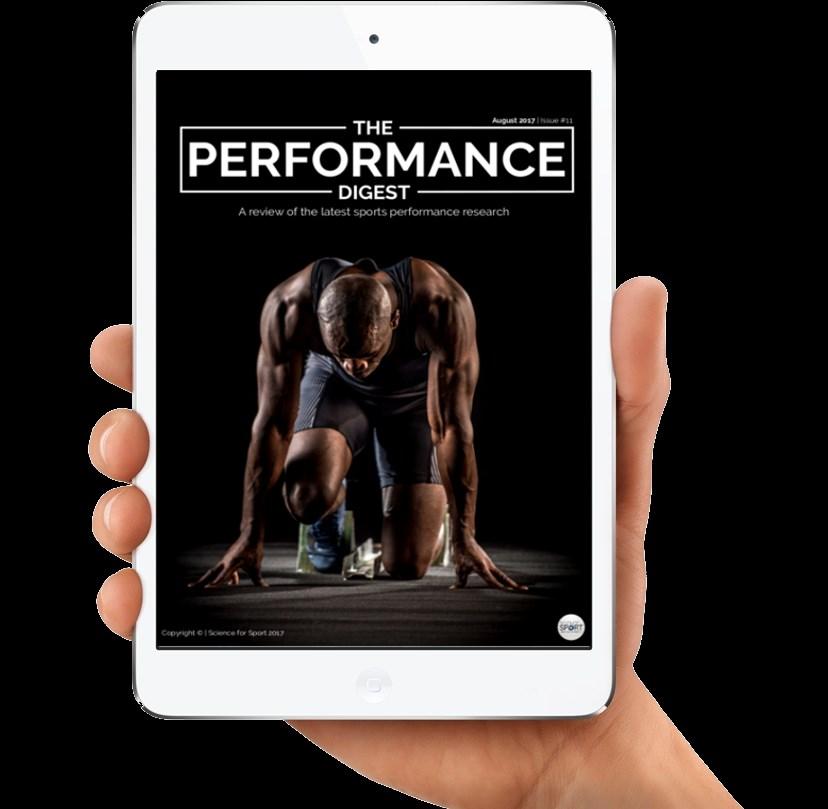

Study Details



Study Details
Practical Takeaways from study
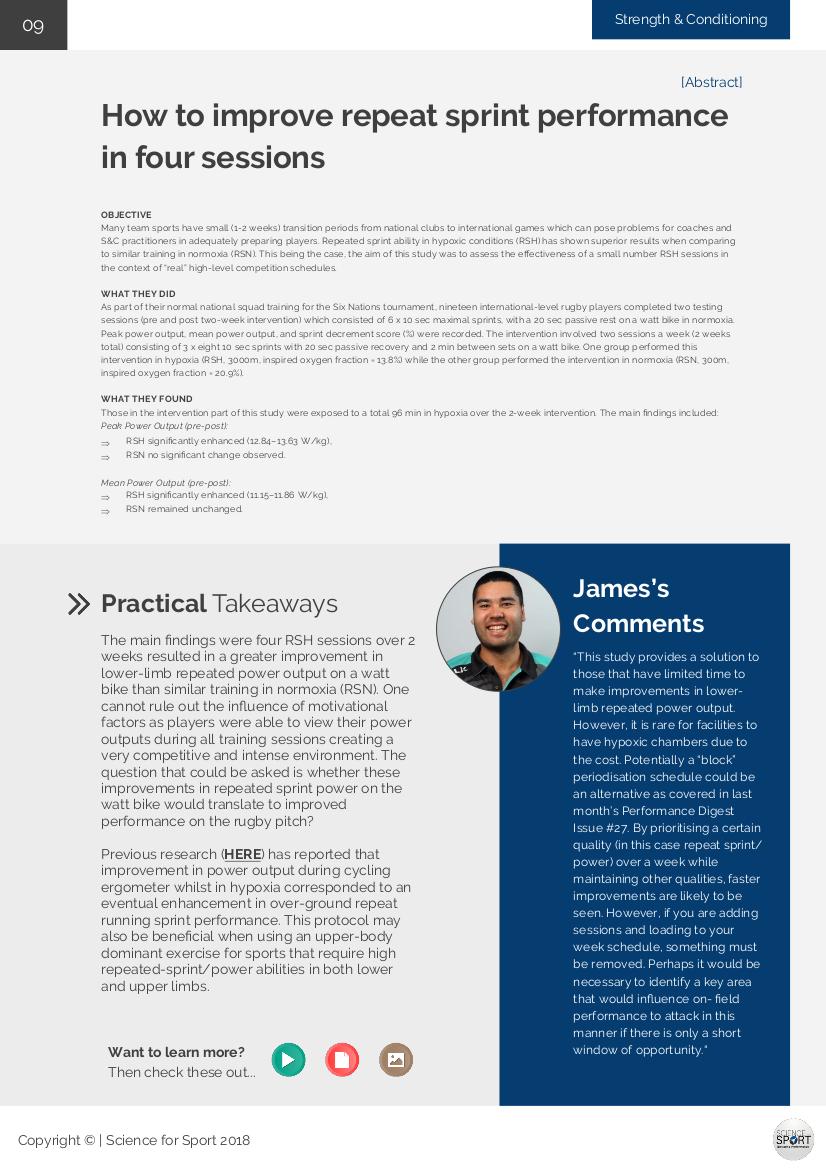
Related links to learn more about the topic
Reviewers comments on the study





Will is a Lecturer of Sport Coaching at Deakin University, Australia. Prior to this he has worked with Cricket NSW and Cricket Australia in an array of roles ranging from a sport scientist, development coach and a strength and conditioning coach. He completed his PhD at the University of Newcastle, Australia within the area of practice design.
Tom is the Head of Athletic Development at St Peters RC High School. He holds a Masters in S&C and has previously worked with West Bromwich Albion FC, Gloucester Rugby club, and Great Britain Equine. Tom is our youth research reviewer at Science for Sport.
James is currently the Head Strength & Conditioning Coach for the Romanian Rugby Union. He has previously worked in America's professional rugby competition Major League Rugby with Austin Elite and the NZ Women’s National Rugby League Team. He is a published author and has completed a MSc in Sport & Exercise Science from AUT, Auckland, NZ.

Technology & Monitoring
Cody is a strength and conditioning coach and adjunct lecturer at the University of Iowa. He has an MSE in Exercise Science from the University of Kansas and also holds a CSCS from the NSCA.

James is a Performance Nutritionist for the English Football Association and works alongside the England national teams (men's and women's). He is also a SENr registered performance nutritionist and holds a PhD from Liverpool John Moores University.



OBJECTIVE
One of the more commonly understood roles of a coach is the development of a training program. The objectives of these programs quite often change, whether that be the physical, technical, tactical, or behavioural demands of athletes or varying combinations of each. With respect to the physical demands of athletes, to ensure they are not overworked and receive sufficient recovery time between training sessions, a coach needs to consider the loads at which their athletes train on a regular basis. many cases nowadays, rating of perceived exertion (RPE) and session rating of perceived exertion (sRPE) is provided by athletes. This allows coaches to monitor the physical demands of their athletes and modify training programmes accordingly.

Despite the global use of RPE to limit overuse injuries or overtraining as a result of high training loads, these phenomena persist. A possible reason for this is a coaching mismatch between the training loads required of the athletes and how they perceive these prescribed training demands. The authors of this study set out to 1) determine if the training program designed by a coach differed to how their athletes completed it, and 2) determine if the planned intensity and training load differed to that perceived by the athletes.

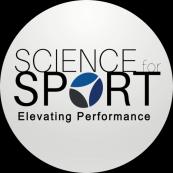
Eleven (semi-) professional cyclists (age = 21 ± 3 years) completed individualised training programmes over a seven-month period that was designed by their coach. For each training session, the coach estimated the intended RPE (based on Borg s 6-20 scale, see HERE) and its duration. This information was not made available to the athletes at any point of the training program. Each athlete was required to provide their RPE following each training session.
Comparisons between the intended execution (i.e., did the athletes do what was asked of them) of the training plans,the RPE of the session, as well as the intended sRPE (calculated as duration of session multiplied by the RPE), took place at the completion of the training program.
Execution of training program
Overall, no difference was reported between the mean planned duration of each training session and the mean actual duration of each training session. However, mean sRPE tended to be greater than the intended sRPE.
When examined individually, there were examples where the duration of the session was shorter than intended, combined with a lower reported sRPE than intended.
Perception of training program
Overall, no differences were reported between the recorded and intended RPE or the sRPE.
When reported per cyclist, several participants’ RPE varied (i.e., either greater than or lower than) to the intended RPE.
During low-intensity and high-intensity training sessions, the cyclists reported a lower RPE than was intended.



The authors of this study note that different cyclists – and likelyathletes from any sport
may perceive the same training session in slightly different ways, which can bring about different adaptations. For example, ifthe intended RPE for a session is 17AU and one cyclist perceives this as 14AU but another 19 AU,this has implications for future planning and workload requirements, aswell as recovery.
To address potential differences between what is intended by thecoach and what actually takes place during a training session, theathletes could be provided with the intended RPE at the start of asession or activity.
Although the interpretation of the same RPE might differ amongindividualathletes, each would aim to complete the session basedon this interpretation. This allows the coach to plan future sessions with the knowledge of what each individual needs to doto reach the intended RPE.
Then check these out...
You need to remember that each individual athlete is unique, which means they may not conform to your intended, best-laid training plans. Every athlete will react to the same stimulus in a slightly (or possibly drastically) different way and it is your responsibility as the coach to manage this as best you can. It is your responsibility as a coach to combine the information provided to you (i.e., analytical data such as RPE) with observations you make during a training session (i.e., how did each athlete respond to each activity?).
"Combining this information will help you individualise your training plans and improve the chances of continued development amongst your athletes."

BJECTIVE


Competition is the ultimate measure of training progress and effectiveness, especially in the sport of track andfield, where athletes are focused on performing their absolute best on a specific date.But assessments before and during preparation help to organise and guide training to develop specific qualities (e.g., speed, strength, endurance) that will support performance.
Within running specifically, there is a range of training methods that help develop an athlete’s abilities (e.g., maximal oxygen consumption, velocity at lactate threshold, and running economy), ultimately leading to improved speed and endurance. However, the looming question is: what is
the‘best’training method and distribution that maximises athlete potential and improves performance in a given race?
Taking time to thoroughly assess, plan and monitor training over time is the best way to learn what approach
is most effective, using results as feedback to help adjust and modify for the future, continuing to improve overall preparedness.
This specific body of research investigated a full year of training of a single elite mid-distance runner leading intoa World Championship competition (Doha 2019), looking specifically at the training intensity distribution methodsand a retrospective analysis of the physical abilities and training methods.
Training information (total distances, durations, session intensities) and race results were observed for a male middle-distance runner over a year, leading into the World Championships in Doha (October 2019).
Maximal oxygen uptake and lactate concentration were measured during an incremental treadmill test at the beginning of the training year (September 2018) for baseline information to guide training zones and classify intensities. Training was examined in four blocks of time, the full 52-weeks, as well as the 26-, 12-, and 6-week time periods prior to the championship race.
Sessions were prescribed using a combination of heart rate and specific pacing based on the targeted intensity (easy, threshold, or interval sessions). Using the velocity at first and second lactate threshold to categorise training into three zones (see HERE), the percent distribution of overall total training volume was analysed to showcase how it changed leading into competition
Assessments of performance (e.g., time trial, jump height or distance, maximal strength, etc.) at the start of a training period help to provide a baseline measure, offering feedback on the efficacy of the training plan and athletes’ progress in a given quality if tested consistently every 4-6 weeks. Staying consistent with this over multiple years of training can further guide preparation and necessary adjustments to training.

Assessing performance separate from the specific sport or event can also guide specific training prescriptions by highlighting areas of weakness, giving athletes individualised targets to focus on. To that end, it is important to identify assessments that provide feedback for physical qualities that specifically influence performance in the given sport or event. For example, running a 200m time trial can be a predictor for speed endurance potential in a 400- or 800 m race, or in field-sport athletes, the 30-15 Intermittent fitness test can showcase aerobic fitness ability.
Training in endurance sports (e.g., running, swimming, etc.) typically have a very high volume of lowintensity aerobic work. This is an aspect of training that generally builds over an athlete’s career, and although improvements in oxygen uptake can happen within weeks (see HERE), other adaptations with mitochondrial biogenesis and enzyme function can take as many as 8-10 years to accumulate (see HERE). It is important this volume is progressed gradually and is performed patiently; this steady-state work supports training progress and provides a protective effect, improving durability and longevity.
Performing assessments to guide training and completing a high volume of work is helpful to the training process, but the one aspect that should always take precedence is the athlete s health. This means coaches should prioritise recovery, building in off-days and looking for warning signs of overtraining. Coaches should aim to be flexible with training, appreciating an athlete’s subjective feedback, and not over emphasising any one specific assessment over another. The ultimate measure of progress should be an athlete feeling positive and confident about their training, and a successful performance in competition. An assessment is merely feedback, guidance, and an opportunity to evaluate an athlete physically and mentally

Then check these out...
Most importantly, the athlete achieved personal bests in the 1500- and 10,000m events, running within 0.4 seconds of his personal best in the 5000m, finishing 12th at the World Championship event.
Consistent with high-level distance runners (see HERE), the majority (~75% of sessions and ~85% of total volume (time) of training is considered ‘easy’ or ‘zone 1’, determined by a pace below velocity at lactate threshold one or below 80% of race pace (<18.3 kmÿh-۱).
As the date of the championship race neared, there was a steady increase in the amount of higher-paced ‘zone 3 ’work that is closer to race pace (i.e., greater velocity than lactate threshold two or > 95% race pace (20.3 kmÿh
-1) and a decrease in the ‘zone 2’ volume across the year. This shift towards more ‘polarised’ training occurred gradually across the four time periods (52-, 26-, 12-, and 6 weeks prior to competition).
“Looking at a case study like this offers insight and direction into important performance variables to assess among runners (e.g., maximal oxygen consumption, velocity at lactate threshold) and allows us to appreciate the necessity of considerable amounts of easierpaced running within an elite athlete’s training program. It is common to complicate the interactions of training, performance, and the human body at all levels of performance (e.g youth, university, professional).
“This overview reminds us to perform assessments that matter, which means they are valid, reliable, and we use them to guide the training process. Further,we must understand the demands of the given sport or event and prescribe accordingly based on the physicalqualities that need to be developed.

“Ultimately, with endurance sports, the aerobic component is going to make up the majority (~85%) of the total training time, with only three ‘key’ or high-intensity (primary) workouts occurring across the week. With any training, it is a balance of volume and intensity. For elite, experienced athletes, volumes will typically be higher, and intensity is managed appropriately to spread evenly across the week.
“Remember to not get carried away with any variable, and allow time for recovery, improved readiness, and high-quality performances. This promotes positive adaptations over time, as well as athlete health, and most importantly,consistent and progressive training.”
This month’s top research in strength & conditioning.
DO DROP SETS INCREASE MUSCLE SIZE AT DIFFERENT REGIONS OF THE QUADRICEPS?
VERTICAL OR HORIZONTAL FORCE-
VELOCITY PROFILING - WHICH IS BEST FOR RUGBY
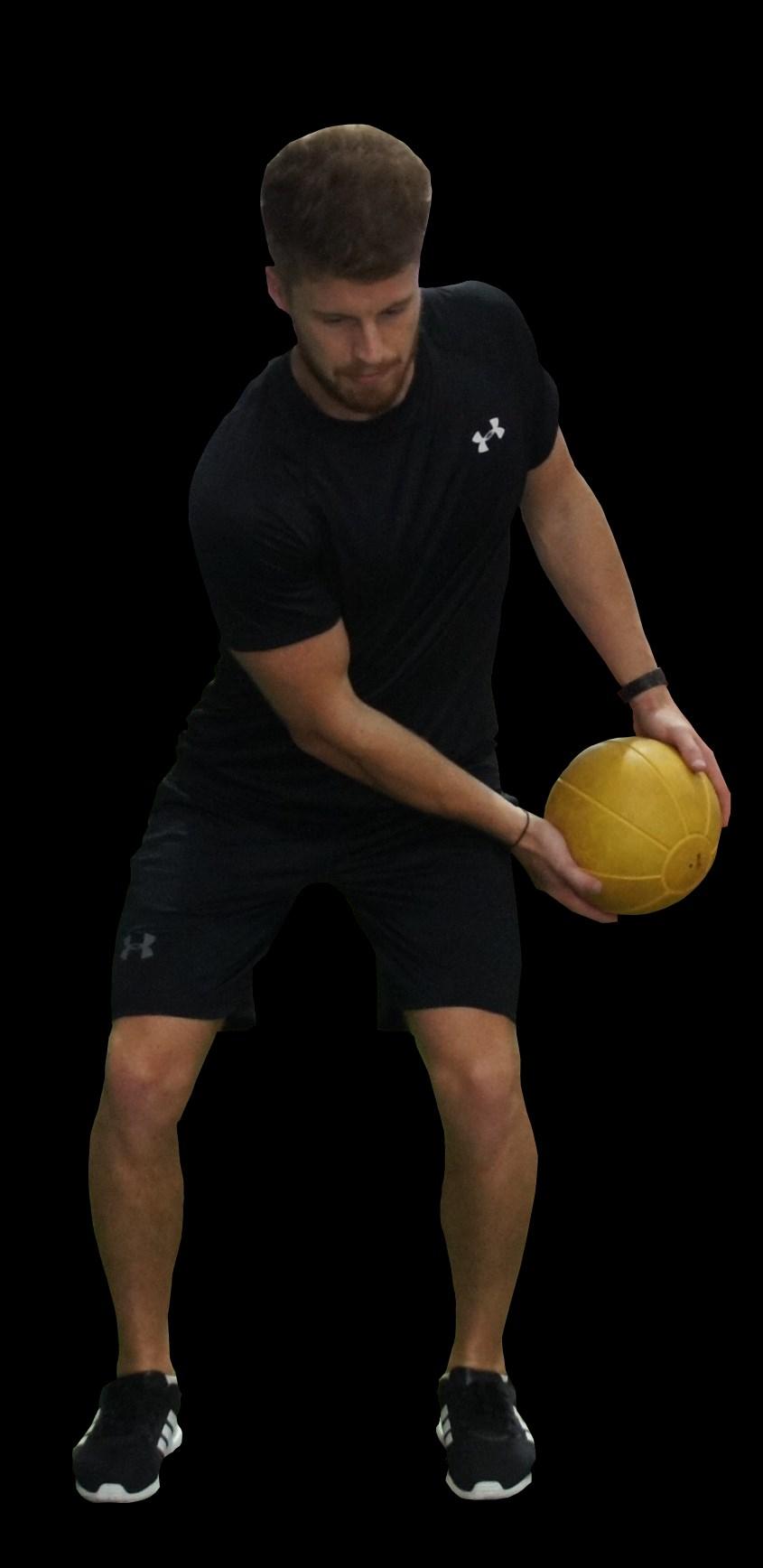

STRATEGIES TO MEASURE AND MODIFY STRENGTH TRAINING
ARE ASSISTED OR RESISTED PLYOMETRICS BETTER FOR JUMP AND SPRINT PERFORMANCE
Drop sets involve performing a set to failure, reducing the load and then continuing the set until failure again. These can be single, double, or triple drops and is an intensity technique used by bodybuilders and physique athletes to increase muscular fatigue and enhance metabolic stress.
While research is not entirely conclusive regarding drop sets being superior to traditional sets for muscle size, it is not clear whether differences in hypertrophy exist in different regions of the muscle, which may provide more insight into the mechanisms presented through drop sets.
Therefore, this study aimed to compare drop sets vs. traditional strength training sets on muscle strength and regional hypertrophy of the quadriceps.
Sixteen young men (age = 19.21 ± 1.1 years) were randomized into either a right leg drop set, left leg traditional set method group or vice versa. Muscle thickness of the vastus lateralis and rectus femoris through ultrasonography was measured at 30% (proximal), 50% (mid), and 70% (distal) along the muscle length before and after the intervention. Maximal concentric isokinetic strength at 60°/s and 1RM leg extension were also tested.
The resistance training intervention lasted eight weeks with the drop set protocol consisting of a 5RM load to failure, reducing the load by 20% to failure again, then reducing the load by 10-15% to failure. The traditional strength protocol consisted of 15RM to failure. Volume defined as the number of sets performed was equated between protocols.
Subjects progressed from one session a week of three sets, to three sessions a week of 15 sets. SCIENCE FOR SPORT PODCAST EP 72

There are three main reasons we may have seen greater regional hypertrophy in the rectus femoris compared to traditional sets:
1. Leg extensions preferentially target the rectus femoris over the vastus lateralis (see HERE).
- The rectus femoris is primarily activated through leg extensions whereas the vastus lateralis is primarily activated through closed chain squat exercises. Therefore, we could speculate that if this protocol was used during a single-leg leg press, we may see greater hypertrophy of the vastus lateralis.
2. The rectus femoris is placed under a greater loaded stretch.
-Training a muscle at long muscle lengths induces greater hypertrophy than shorter muscle lengths. For example, deep squats elicit greater hypertrophy of the quads than shallow squats (see HERE).
The drop set protocol involved greater volume load enhancing hypertrophy of the targeted rectus femoris.
Volume is a key driver of hypertrophy. There is a clear dose-response relationship between volume (defined as the number of sets per muscle group per week) and hypertrophy (see HERE). While the number of sets were the same between protocols, the drop set group had a greater volume load, likely influencing muscular growth of the rectus femoris.
Interestingly, when volume is equated, we either see no difference between drop sets and traditional sets, or a trend favouring drop sets (see HERE and HERE). So, it seems drop sets should mainly be used as a technique to increase training volume without significantly increasing total training time.
Here are some guidelines when employing drop sets for the purposes of hypertrophy:
Opt for isolation-based movements with a preference towards using machines. While you can use big lifts like squats and bench presses for drop sets, there is a risk of deteriorating technique increasing the risk of injury and promoting systemic fatigue that will increase your recovery time between sessions.
Use this intensity technique in blocks. You don’t need to use these every workout all the time. Use them for two-to-four week blocks for certain exercises to intermittently spike training volume to spur new muscle growth.
Avoid drop sets with competitive sporting athletes. The increased fatigue and volume are not worth the potential increase in muscle mass.
While total training volume did not differ (sets x reps), volume load favoured the drop set protocol (sets x reps x load). No significant differences were found between protocols for 1RM or maximal concentric isokinetic strength. No difference in muscle thickness was seen in the vastus lateralis.
However, drop sets elicited greater regional hypertrophy than traditional sets in the rectus femoris. A 17.7% increase was seen in the proximal portion versus 3.7%, 8.3% at the mid portion compared to 3.6%, and no significant differences seen at the distal portion.





“Interestingly, hypertrophy was favoured at proximal and mid portions of the rectus femoris. I would think the leg extension would favour the distal and mid portions due to the distal portion being under greater stretch compared to the proximal portion. Regardless, if your goal is purely physique-related and not performance, using drop sets should be part of your training intermittently.
“Further, if you are a weekend warrior who doesn’t have much time to train, drop sets can allow you to get extra volume in shorter periods of time compared to traditional sets, which could be a viable strategy for a quick workout. For example, you could start a session with traditional sets of squats, then move to the leg press for a double drop set, and finish on the leg extension with a triple drop set.”
OBJECTIVE
An athlete's force-velocity (FV) profile can be assessed bothvertically, by jumping, and horizontally by sprinting.
It measures the maximum capabilities (force, velocity, and power) that underpin athletic performance.
FVprofiling provides prescriptive information that caninfluence programming, going far beyond the simple measures of jump height and split time by Currently, it is unclear whether jump and sprint (vertical and horizontal) FV profiling can be used interchangeably and what their associations are within a youth athlete population. Therefore, this study investigated the relationship between jump and sprint profiles and their accompanying variables on sprint performance in youth rugby league players. Additionally, FV profiles were compared between positional groups (forwards and backs).
SCIENCE FOR SPORT PODCAST EP 72

Twenty male Super League academy rugby league players (age = 17.6 ± 0.9 years) completed both avertical and horizontal FVprofile test. The vertical FVprofile consisted of the squat jump using loads of 0-, 20-, 40-, 60-, and 80 kg. Participants paused for two seconds at a 90-100 degree knee angle before jumping as high as possible twice with each load. Jump height was measured using an Optojump optical measurement system. FVmechanical variables were then calculated, including absolute and relative theoretical maximum force, theoretical maximum velocity, absolute and relative maximal power, the slope of FVrelationship, and FVimbalance.
The horizontal FVprofile consisted of two 40-metre sprints measured with a radar gun device. The same mechanical variables were calculated as the vertical FV profile, except for the slope of FVrelationship and FV imbalance. Further, the ratio of force was calculated over the entire acceleration phase, with the decrement in thisratio (representing how much force is directed horizontally) also calculated.
Comparisons were made between forwards and backs, and correlations were made between vertical and horizontal variables. Finally, both vertical and horizontal FVvariables were correlated with sprint performance (split times and momentum).
Based on these data, the horizontal FV profile is a great test to help guide your programming when looking to enhance sprint performance. The vertical FV profile maybe better suited to jump-dominant sports such as volleyball.
Not everyone has access to sports scientists and expensive technology such as radardevices. Instead, you can use a cheap app called My Sprint, which allows you to calculate horizontal FV profiles with your phone or iPad.



Here are my field-tested tips for testing horizontal FV profiles with a large squad ofathletes using the My Sprint app:
Record all of your athletes’ sprints on camera (not in the app) in slo-mo or 60 FPS.Import and analyse the sprints in the app after the session. If importing slomo videos,set FPS to 120 (double-check your slo-mo frame rate).

Record all of your FV variables from the app in an Excel spreadsheet and sort yoursquad by ratio of force. This first step seems to influence the rest of the sprint and variables. You ll find this mostly orders your players fastest to slowest and by absolutemaximal force and power.
Calculate a Z-score (this is a great video to help) for each player and place anyone one standard deviation above the mean ratio of force into a velocity deficit’ group. Anyoneone standard deviation below can then be placed in a ‘force deficit’ group. The rest arein the ‘well-balanced’ group.
If you program gym sessions as forwards and backs, groups can be made within each cohorttherefore, for each cohort, you ll make minor programming changes to address velocity, well-balanced, and force profiles.
In my experience, these changes are relatively minor to where running three different programs for forwards and for backs isn’t too difficult to manage.
Want to learn more?
Then check these out...
Positional Differences:
Forwards showed greater absolute theoretical vertical (24%) and horizontal (18%) maximum force and momentum at 0-10m (17%) and 30-40m (13%) than backs.
Backs were faster than forwards from 10-20m (5.4%) and 30-40m (5.9%) and jumped higher unloaded (8.2%) than forwards.
A force deficit was the most common FV imbalance among players.
Correlations between jump and sprint variables
No significant associations were found between jump and sprint mechanical variables. Correlations between jump variables and sprint performance
Very large correlations (r = 0.71-0.75) were found between absolute theoretical vertical maximum force and momentum at 0-10m and 30-40m.
No other vertical FV variables were significantly associated with sprint performance.
Large to very large negative correlations (r = -0.53 to -0.88) were found between theoretical maximum horizontal force and split times and momentum at 0-10m.
Relative theoretical maximum horizontal force was largely to near perfectly negatively correlated with all split times (r = -0.52 to -0.98).
Moderate to near-perfect negative correlations were seen between theoretical maximum velocity and 10-20mand for split times above 20m (r = -0.47 to -0.97).
Maximal power and all split times were moderate to very largely negatively correlated (r = -0.47 to -0.78) with relative maximal power showing up to near-perfect correlations for the same split times (r = -0.60 to -0.99).
Moderate to perfect positive correlations were found between the slope of the FV profile and 0-2m and 0-10msplit times (r = 0.49 to 1).
Maximum velocity showed large to near-perfect negative correlations with 0-20m and 0 -40m split times (r = -0.63 to -0.98).
"This is the second study that supports my belief that non-jump dominant sports (such as either rugby code) shouldn’t concern themselves with vertical FV profiling. You can read the first study, showing that improvements in vertical FV profiling didn’t translate into improvements in 10- and 20m sprint times, in Performance Digest Issue #48.
"Personally, I only use horizontal FV profiling with my rugby athletes as these results can influence my programming to directly enhance on-field performance. Adding vertical FV profiling takes more time away from training for a test that likely won’t help make my athletes better on the field. Instead, I like to test their reactive strength index (RSI) along with the horizontal FV profile, which gives me an indication of each player's reactive ability.
"Using this data, I can then group athletes based on reactive ability and force or velocity deficits, and provide them with individualised programs, no matter how big the squad may be."

Monitoring athlete performance can provide crucial feedback for managing daily readiness and improving overall preparedness for competition.
This review outlined the various techniques used to measure and modify strength training intensity, offering suggestions of how and when to implement each method.


The authors provided a detailed summary of how to best approach the monitoring of strength training intensity and outlined numerous methodsto do so. The benefits and drawbacks and appropriate usage of each of the following methods were highlighted:
Linear loading (the gradual progression of training load, see HERE).
The Two-for-two rule (increasing loads when performance improves and stabilises across consecutive sessions, see HERE).
Percentage of one repetition maximum (%1RM) (manages intensitybased on percentages of a one-repetition maximum performance, see HERE).
Repetition maximum zones (selecting loads based on a repetition range, see HERE).
Rating of perceived exertion and repetitions in reserve(subjective ratings of effort to measure intensity, see HERE).
Set-repetition best (allowing for weekly adjustments based on variations in performance, see HERE).
Autoregulatory progressive resistance exercise (modifying training workout by workout, based on prior performance,see HERE).
Velocity-based training (measuring barbell displacement to assess performance and quantify intensity, see HERE).
Most notably, a steadfast respect for consistent and quality exercise technique is paramount for tangible and effective progress. This is a concept that must be instilled in athletes from the beginning and supported by coaches throughout every session.
In strength exercises, coaches should emphasise the training process more than the result (load lifted) by using alternative performance metrics (e.g. sprint times, throw distance, vertical jump height) to highlight improvements in relative sportspecific tasks.
As a coach, it is important to adapt the monitoring methods used based on the relative experience of the athlete or group and understand that there is no single best method.
Beginners can progress well with simple and steady methods like linear loading or the two-for-two rule.



Although training close to failure is an important aspect of progressive overload, the methods employed to encourage maximal effort should also help identify significant reductions in performance and the need to reduce training. This allows for fatigue to resolve and adaptation to occur.
Finding a strategy that allows for adjustments (autoregulation) based on readiness and performance has shown to be most effective. Reducing the opportunity for training monotony is important to success.
In order to promote better skill acquisition and adaptations related to sport performance (e.g. jumping and sprinting ability), prescribing a range of loads and velocities at varied effort levels (e.g. maximal and submaximal) over time shows the greatest long-term benefit.
For a more experienced athlete, pairing an athlete’s subjective rating of perceived exertion or repetitions in reserve with another method such as %1RM or velocity-based training can provide objective performance feedback while simultaneously promoting autonomy.
Want to learn more?
Then check these out...
Although methods (e.g. linear loading) can be beneficial initially, some lack the longterm variability needed to allow for adaptation.
Caution methods (e.g. two-for-two rule, setrepetition best, orautoregulatory progressive resistance exercise) that emphasise training to failure have the potential to result in the neglect of exercise technique.
The %1RM method is inaccurate due to the daily fluctuations in athlete readiness and variability in repetition capacity at agiven percentage (e.g. reporting the ability to perform from 11to 20 maximal repetitions at 70% 1RM, see HERE ).
Using a combination of methods, pairing subjective (e.g. RPE) and objective values (e.g. weight, repetitions, or mean barbell velocity), can be most advantageous in showcasing ability while simultaneously allowing for the flexibility necessary to promote adaptation.
"There are numerous avenues to choose from when it comes to methods that quantify performance and help systematically manage strength training volume and intensity. Especially with a ‘weight room’ heavy bias, it is easy for S&C coaches to become overly focused on various schemes related to lifting heavier and showcasing strength improvements.
"However, what is most important is to keep a holistic view of the athlete and the various qualities that need to be developed relative to their sport. The primary aim for any of these methods must hinge on the ability to best manage fatigue and support long-lasting performance enhancement. Efforts to get stronger should not be at the detriment of an athlete s overall psychophysiological wellbeing but instead, support all aspects of their training efforts. Lifting with proper technique is an important element of this, but once established, there needs to be some form of data collected to help coaches learn and understand how to best prescribe training load given the circumstance and situation.
"Employing these methods strategically allows an athlete to train with purpose while also demonstrating productive progress along the way.

Plyometric training is not limited to solely bodyweight - they can be enhanced through adding assistance or resistance through elastic strength bands. The idea of assisting the plyometric movement is that it results in faster muscle contractions and higher movement velocities due to deloading some bodyweight, whereas resisted plyometrics would enhance muscle force production and result in slower movement velocities.
This study investigated the effects of assisted or resisted plyometric jump training on countermovement jump (CMJ) and sprint performance.
Fifty-six physically active females (age = 19-26 years) were randomly assigned into an assisted plyometric (AP), resisted plyometric (RP), or control (CON) group. The control group did not perform the intervention but remained active. No subjects performed regular plyometric or sprint training in their normal routines.
Subjects completed a CMJ and 40m sprint test before and after the training intervention. The training intervention lasted eight weeks where subjects performed CMJs, Bulgarian split jumps, and broad jumps either with assisted or resisted band tension. Sessions ranged from 2-3 per week , of increasing volume.






For coaches working with untrained females or males, working on the strength side of the force-velocity relationship seems to lead to greater performance improvements than the pure speed side.
Plyometrics and jumps can also be loaded by holding kettlebells, dumbbells, plates, or by wearing a weighted vest.
Performing a well-designed strength training routine would likely provide an even greater improvement in CMJ and sprint performance given these participants didn’t have a strength training background.
Here’s how you could design a simple strength training program combined with resisted plyometrics and jumps:
A1) Weighted Pogo 3 x 20 (holding light medicine ball)
B1) Back Squat 3 x 6 @ 7-8 RPE
C1) Romanian Deadlift 3 x 8 @7-8 RPE
D1) DB Step Up 3 x 10/leg @7-8 RPE

For those working with better trained athletes, these results cannot be translated to your population. The results in highly trained athletes would likely be dependent on individual force-velocity profiles.
Those athletes who have force deficits would potentially see greater improvement with the resisted condition while those with velocity deficits would see greater improvement with the assisted condition.
Want to learn more?
Then check these out...
The RP group saw a 3.58cm improvement in CMJ while the AP and CON didn’t see any significant change. The RP group also improved maximum velocity by 0.30 m/s-1 while the CON group improved by 0.24 m/s-1. The AP group saw a trend for a slight decline in maximum velocity, with the RP group showing a significant difference compared to the AP group. None of the groups saw significant changes in 20- or 40m sprint times. The CON group reported a higher average training volume before and after the intervention by 1-3 hours, which may have contributed to the small improvements in sprint speed.
“This is one of those studies where you must only apply the results to the current population. The reason for greater gains seen in the band resisted group was likely because the subjects were physically weak. Adding resistance provided a greater force stimulus than the assistance group, resulting in improvements in jumping and sprinting.
“In my experience with collision sport athletes, they are usually highly strength trained and have neglected the high-speed component of training. Assisted plyometrics and jumps are great to use for this population of athletes.”
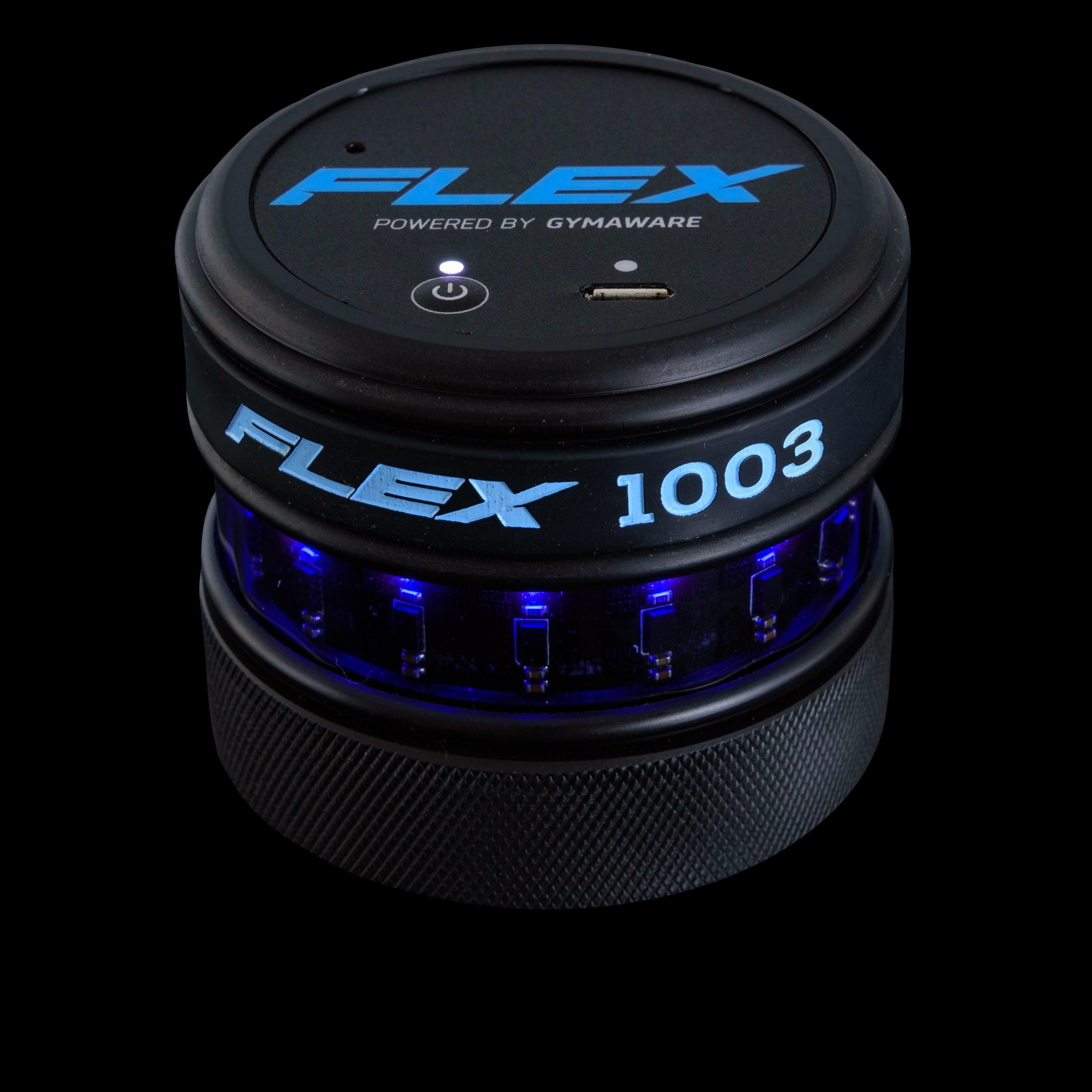
This month’s top research on technology and monitoring.
RWHAT TRAINING LOAD MEASURE PUTS ATHLETES AT RISK OF ILLNESS ?
WHAT IS THE BEST APPROACH FOR ASSESSING SLEEP HYGIENE?

The goal of training load (TL) monitoring is to reduce the likelihood of overtraining as this can increase an athlete’s susceptibility to injury or illness (see HERE). Further, overtraining can lead to suppressed immune function, with an increased incidence of upper respiratory tract infection (URTI).
Although advancements in technology have allowed for numerous internal and external quantifications of TL, calculating TL with session rating of perceived exertion (sRPE), which is an athlete’s subjective report of training intensity multiplied by the session duration, has remained a simple, valid, and reliable method (see HERE). TL monitoring is common practice in sport, but the relationship between TL metrics and occurrence of URTIs has not yet been explored. Therefore, this study examined a number of commonly used methods for sRPE-based TL monitoring (e.g., acute:chronic workload ratio (ACWR), weekly cumulative loads, training strain or monotony, etc.) and their association with URTIs across a soccer season, noting the time between TL spike and subsequent illness (lag period).
SCIENCE FOR SPORT PODCAST EP 30


Fifteen male outfield soccer players (age = 23.4 ± 4.8) from a senior first team in the Irish Premier League agreed to provide sRPE data across a 40-week soccer season for all competition games and training sessions. Data was collected through a smartphone application, alongside any symptoms related to illness (e.g. nasal congestion, headache, sore throat, sneezing, cough, etc.). Confirmation of a URTI was documented when an athlete reported two or more symptoms for two or more consecutive days.
Using rolling weekly analysis, numerous TL metrics were calculated from daily sRPE values (e.g., uncoupled ACWR, exponentially weighted moving average ACWR, and 2 -, 3-, and 4-week cumulative load values, see HERE) and a one to seven day ‘lag period’ (time between TL and onset of URTI) was examined.

For sRPE values to be valid and reliable, coaches must take the time to help athletes understand RPE and associate the intensity of effort experienced with specific values on a 1-10, or 6-20 Borg scale (see HERE) (e.g., differentiating between maximal exertion, extremely hard, extremely light, or no exertion corresponding number of each). It is important to be consistent in the explanationand verbiage used.
If the monitoring strategy (e.g., sRPE) is supportive of the athlete’s health and performance, it is important to remain committed to data collection and ensure athletes become accustomed to the reporting process. Some strategies to do so are as follows:
Make data collection a fluid process for the athlete by sending them a message totheir smartphone and collecting the information electronically to help boost compliance.
Follow up with athletes who fail to report the information required. Explain why and how it can be useful for you as a coach in planning training and keeping them healthy, and emphasise that it is not information to be used against them.Make adjustments to TL and have a private conversation with any athlete showing signs of fatigue or overtraining - this shows that the coaches care about the athlete s feedback and value their wellbeing.
Although an elevated TL can be beneficial in preventing injury and illness (see HERE), it is important to periodise training and subsequently avoid extended periods of high TL, reducing the cumulative effects of fatigue.
This may mean allowing for periodic (weekly) recovery days or even reducing TL by as much as 50% for extended periods (3-5 days, see HERE).
Educate athletes on appropriate recovery (e.g., adequate sleep and nutrition)and sanitation practices (e.g., hand washing or cleaning living space regularly)to support immune function and reduce the likelihood of illness. Further,distancing from sick teammates and not drinking from the same bottle canreduce the spread of potential contagious illnesses.
Want to learn more?
Then check these out...
The only two TL metrics that were associated with an URTI were 2- and 3-week cumulative loads.

A high 2-week cumulative load (>3500 arbitrary units) had the greatest risk of an athlete experiencing an URTI three days later.
When 3-week cumulative load was high (> 5193 arbitrary units), an athlete had an increased risk of URTI four days afterward.
"Training hard and consistently is no doubt important, but it cannot occur at the detriment of athlete health and wellbeing. It must be balanced and planned appropriately, respecting the accumulation of work and potential fatigue that puts athletes at risk of illness or injury. Taking the time to obtain athlete feedback, as well as managing the volume and intensity of workload, enables a better understanding of the dosage of training and an athlete’s response.
"With this in mind, taking the opportunity to monitor multiple metrics, both subjective and objective on an individual basis, can be extremely helpful in identifying insufficient recovery and the need to alter training. This will take time, requiring patience and consistency from the coach in collaborating with the staff and roster to be effective.

"With coaches often getting caught up in focusing on the current day and upcoming competition, training load monitoring is important to maintain a historical account of the volume and intensity of stress athletes experience. With proper data collection and analysis, coaches can respect the past and support a team’s future, by keeping the best athletes healthy and available to compete."

Sleep is a crucial, individual-specific aspect of maintaining and maximising athletic performance
(see HERE)
Numerous influences (e.g., history, social pressure, training load, behaviour before, and bedroom situation) affect an athlete’s ability to maximise the restorative benefit
Through a mixed-method approach (the combination of quantitative and qualitative data collection), a better understanding of sleep, recovery, and performance is possible, further providing opportunities to support and improve athletes. Therefore, the objective of this study was to utilise such an approach to identify relationships between sleep and potential stressors that may impact the sleep habits of elite athletes.
SCIENCE FOR SPORT PODCAST EP 13


Fifteen elite athletes (seven males, eight females) training at the French Institute of Sport in individual sports (e.g., archery, fencing, athletics, judo, weightlifting) had their sleep assessed using a wristworn activity monitor, examining numerous variables (e.g., total sleep time, wake after sleep onset, sleep efficiency) during an in-season, noncompetitive training period.
To gain a thorough understanding of each subject’s sleep patterns and influences, sleep questionnaires (Spiegel Sleep Inventory, Pittsburgh Sleep Quality Index, and Morningness-Eveningness Questionnaire) were completed alongside the collection of daily measures of tiredness when waking and training load using RPE. Additionally, individual interviews regarding sleep history were conducted with each participant. For an unbiased analysis, the information from the interviews was transcribed and examined using a coding system to identify themes.
Overall, participants individual sleeping patterns were assessed, along with the stressors affecting their sleep.
It is vital to equip athletes with the skills to adapt to variable sleeping environments, especially those who travel for training camps and competitions. Aiming to control and mitigate as many potential distractions as possible (e.g., traveling with black-out curtains, tape to cover lights, earplugs, an eye mask, a fan for ambient noise and to keep body temperature controlled, a pillowthe athlete is accustomed to using, etc.) can be helpful to improve sleep in an unfamiliar environment.
Sometimes the best thing a coach can do is to minimise awareness to a specific area,especially sleep. Inquiring too frequently or during challenging times about sleep hygiene can
create added stress around the well-understood goal of maximising sleep and sleep quality.Do not add sleep assessments to a monitoring protocol when in a new sleep environment. It is best to assess sleep during typical at-home time periods for accuracy and identifiable interventions.

Any of the sleep questionnaires used in this study (see above), or a modified version, can serve asa simple and easy tool to generate a conversation around sleep history and personalised approach for a given athlete. The goal with a sleep assessment and intervention is to identify a chronic issue and determine what is the ‘lowest hanging fruit’ (the simplest thing to change with minimal intrusiveness) that can be addressed first.
From a technology standpoint, wrist-worn activity monitors offer a valid and reliable measure of numerous sleep metrics (see HERE). These metrics provide an objective and non-intrusive measure of sleep that can help coaches and athletes gauge recovery and the need for potential sleep intervention strategies (see HERE).
Many times, optimising performance and recovery comes down to optimising scheduling. Whenever possible, allow athletes ample time to wake up in the morning and get something to eat prior to a training session (allowing ≥ 2 hours from ‘wake-up call’ to the warm-up beginning). Doing this improves the quality of training and can subsequently improve recovery,performance, and confidence.
Sleep is a variable and personal aspect for any individual. A general and frequent reminder on theimportance of sleep can be helpful (e.g., aim for eight hours per night, a consistent bedtime, reduced screen time prior, etc.), but a specific and individualised approach offers the greatest return for an athlete who is willing and ready to make a change. If the athlete is willing, have them complete the Pittsburgh Sleep Quality Index and Morningness-Eveningness Questionnaire, identify areas that are weak and pick one thing to progressively change overtime - this will help improve sleep quality and quantity.
Want to learn more? Then check these out...

The primary stressors that impacted sleep were identified as: sleep environment, training demands, and academic requirements.
Based on interviews, eight of the 15 athletes were categorised as ‘complainers’ (versus ‘non-complainers’) because of criticisms relative to sleep environment distractions (e.g., noise, room temperature, mattress quality, level of darkness). ‘Complainers’ exhibited notably compromised sleep efficiency and wake after sleep onset compared to ‘non-complainers
When compared to reports of each participant’s ‘normal’ sleep behaviour (in their own homes), the group averaged roughly 40-minutes less time in bed but slept for a similar duration (~7 hours per night) when sleeping at the training center. This is likely due to the structured in-season training and dormitory environment athletes were evaluated under.
On average, sleep efficiency (total sleep time divided by time in bed) was good (88.3 %). However, high inter- and intra-individual variability was noted among athlete’s total sleep time (7-34% variation) and sleep efficiency (2-33% variation).
Daily training load only showed a slight relationship with wake after sleep onset and sleep onset latency.

“Injuries cannot be predicted or prevented, but managing and mitigating risk factors is essential to athlete health and performance during a season, as well as across their career. There will always be a risk, especially in a contact sport or sports involving maximal intensity, but the aim is to identify risk factors and control what we can as coaches in order to put athletes in the safest and most productive position.
This is only possible through routine monitoring of workloads and identifying markers related to soft-tissue health and athlete performance. Understanding the compounding effect that exists with injury risk therefore, the more information that can be seamlessly collected during training, the clearer the picture of athlete readiness becomes and the more confident decisions are in keeping athletes feeling good and performing well throughout the season. Every day carries a ‘cost-benefit’ analysis and recognising specific players that are more susceptible to injury and need modifications can be the difference-maker in the success of a season.”

This month’s top research on fatigue and recovery.
IS THE HYPE AROUND CANNABIDIOL USE AND BENEFITS FOR RECOVERY REAL?
OPTIMISING MONITORING AND HYDRATION STRATEGIES FOR OUTDOOR SPORT


Cannabidiol (CBD) is a phyto cannabinoid clustered among the cannabinoids extracted from the Cannabis sativa plant and is one of the hottest topics in sports nutrition right now. As recently as the Tokyo Olympics, athletes have reported taking CBD after training sessions and priorto sleep in an attempt to improve recovery,with many claiming anecdotal benefits.
The scientific research investigating the use of CBDin athletes and its effects is largely in its infancy.
Indeed, the physiological, physical and cognitive effects are not fully understood yet.
With many, if not all, elite athletes looking for the easiest and most efficient way to accelerate recovery, it is important practitioners are up to date on the current research landscape regarding CBD.
Therefore, this mini-review examined the evidence supporting the beneficial effects of CBD on recovery from fatigue and muscle damage in sports.


In this mini-review, the authors begin by discussing the prevalence of CBD use among athletes. This could be due to the elimination of CBD from the list of prohibited substances by federations and international institutions of sport.
The physiological mechanism framing CBD intake is discussed next , followed by the evidence regarding CBD use and its effect on inflammation and cell proliferation related to oxidative stress.
Evidence regarding CBD use and the potential benefits for pain and soreness is shared, along sidehow this may translate into helping with sleep disorders, cognition, and mood.


Although an exciting area of research and with many elite athletes currently consuming CBD, more research is required to better understand the underlying physiological mechanisms. As such, practitioners should be careful with the efficacy and safety profile of CBD products when athletes are consuming CBD prior to, during, and after training and competition.
At present, optimal dosing, timing of administration, chronic and acute effects, sex differences with tolerance, professional and fitness level is unknown and therefore makes it difficult for practitioners to know how best, if at all, to use CBD with their athletes.
As previously highlighted by Kasper et al., 2021, there is a clear lack of regulations in CBD production and indiscriminate consumption. Athletes must take caution due to the high risk of testing positive in doping tests.
Considering the literature studying CBD and elite athletes is currently lacking, practitioners are advised to revisit other wellresearched methods to improve recovery following both training and competition. For example, optimal carbohydrate and protein intake, sleep hygiene, caffeine intake, cold water immersion, medication, and blood flow restriction, etc.
The prevalence in the use of CBD among athletes
CBD use among athletes is increasing and is considered the second-most used legal substance among contact sport athletes, replacing nicotine. As an example, 28% of a cohort of professional rugby players reported havin g used CBD, with use increasing with age. Alarmingly, some CBD products have been shown to contain significant amounts of other banned cannabinoids like tetrahydrocannabinol (THC), and athletes should take extra care when reading labels which can be misleading about whether they contain THC ornot.
There is evidence suggesting CBD could induce changes in cortisol release,regulating the inflammatory response to injury. CBD also appears to mediate processes associated with gastrointestinal damage protection due to inflammation and promotes healing of skeletal injuries.
Pain and soreness
CBD consumption may exhibit beneficial effects on pain and soreness, actingdirectly on the central nervous system leading to a sedative effect. However,it is still unclear how CBD affects the pain cascade and pathways. CBD has shown its potential to treat and manage pain in diseases and pain disorders,with potential effects on treating swelling and preventing soreness after exercise.
Sleep disorders
CBD consumption could stimulate the endocannabinoid system, modulating sleep disorders in athletes oreven healthy humans in general. Although endocannabinoid system receptors are associated with sleep-promoting effects, the physiological mechanisms are not yet fully understood.
Cognition and mood
Although there is evidence to suggest that acute and single administration of CBD could have antidepressive effects, there is currently no evidence regarding its long term impact on cognition or mood state. Additionally,studies that do explore both cognition and mood are primarily clinical and preclinical, suggesting the need for more in-depth analysis among the athletic population.
"The more I read about this area of research, the more intrigued and excited I become about future studies. It is clear to see that CBD use is not going away (as mentioned in the podcast below), and its use in athletic circles is ever present. I would personally be very careful working with any athlete who is currently taking CBD or wants to try it. The evidence supporting its use at the elite level of sport is currently non-existent (although, I know of many studies that are either ongoing or about to start) and, on this basis, I would wait until this is published before using CBD as a recovery method.

"If you’re interested in learning more about this topic, a good friend and colleague of mine, Andy Kasper and Graeme Close recently wrote an insightful and interesting blog (see below) and developed a great infographic about their research (below)."
Want to learn more?
Then check these out...

Training in a hot and humid environment can increase the risk of dehydration, reducing bodyweight to a point that performance decreases and an athlete can be at serious risk of heat-related illness. Wet-bulb globe temperature (WBGT) serves as a single measure of the environment (accounting for heat, radiation, humidity, and wind), and is used as an indicator of risk level associated with potential heat illness (see HERE). Likewise, obtaining a subjective report of a session rating of perceived exertion (sRPE) post-session and multiplying it by the session duration provides a valid and reliable measure of the internal load (sRPE-TL) an athlete is enduring (see HERE).
Coaches should try to better understand the impact that climate has on performance and training load, as well as the efficacy of an athlete’s hydration routine during congested pre-season training periods.
The research team examined changes in a calculated measure of intensity from a Global Positioning System (GPS) device equipped with a heart rate monitor and the potential influence that WBGT, sRPE-TL, fitness level (VO2max), or change in bodyweight had on the external load metric.
Additionally, bodyweight was consistently monitored in order to assess hydration habits between sessions during a soccer preseason.
Eleven NCAA Division III women s soccer players (20±1-yr) were monitored during a congested preseason training period (15 sessions in nine days). Prior to preseason, VO2max was estimated by running the Yo-Yo Intermittent Recovery Test (YYIRT), and hydration status and strategies were a primary focus during the training sessions leading up to the preseason period as well.
Bodyweights were recorded before and after each session, on-field WBGT was documented while athletes were warming up, GPS devices were worn to quantify intensity based on velocities achieved, and sRPE taken within 15-min of the end of each training session.
Analysis of this data looked to identify any potential influence on performance intensity on the field, as well as assessment of changes in bodyweight across the entire preseason period



Coaches should take time to educate athletes on what appropriate hydration is and why it is important to their health and performance. Keep this message simple, consistent, and impactful, with continual follow-up in order to be most effective.
If coaches have the opportunity to utilise a GPS device, a sampling rate of 10 hertz (Hz, samples per second) has been shown to be most valid and reliable (see HERE). This sampling rate has shown to be better than 1-5 Hz, with no improvement when using devices that sample at 15 Hz.
For a reliable measure of bodyweight, it is important to weigh athletes using a consistent protocol – regularly calibrating the scale for accuracy, having the athlete wear minimal and consistent clothing (no shoes), and weighing at a similar time of day and circumstances. Doing this provides a more accurate comparison between values and helps in recognising significant changes.
Coaches can assess an athlete’s ability to stay hydrated during a training session by weighing them post-practice in the same minimal amount of clothing that was worn prior to practice. Again, the consistency in protocol leads to a valid comparison, and provides feedback for increasing hydration consistently and steadily throughout a practice session, especially when WBGT is elevated.
Especially for outdoor sports that have the potential to be played in a hot and humid environment, it is important to have a high level of baseline fitness (VO2max), as well as exposure and opportunity to acclimatise to hot environments. This helps to increase tolerance to elevated environments, reducing the chance of performance decrement and the risk of a heat-related illness. Be patient with the acclimatisation process, which can take upwards of 7-14-days to take effect (see HERE)
Coaches should take caution when training in elevated WGBT environments due to increased risk of a heat-related illness, encouraging longer rest periods between drills, allowing more frequent water breaks, and even potentially reducing the volume or intensity of specific drills or the entire session. They should respect that the psychophysiological cost associated with a session performed in hot and humid conditions is greater and will take longer to recover from. Coaches must be careful to not overreach with a given session, as recovery could interfere with competitions later in the week.
When athletes endure higher intensity sessions and note an increased (>1%) loss of bodyweight during a practice, it is helpful to directly provide, or at least strongly encourage, hydration options to replace fluids lost. Milk or a high-protein sports drink can provide not only the fluids needed, but also the nutrients and calories needed to enhance recovery (see HERE).
During a competition, the extended breaks (e.g. end of a quarter or half) within matches is a vital time and opportunity to support performance and reduce injury or heat-related illness. A decrease as little as 1% in bodyweight can decrease performance ability (see HERE), not to mention the elevated risk of heat stroke or related illness (see HERE). It s not necessary to take time to weigh athletes during this period but do encourage and provide them the options necessary to take the field in the second half ready to perform at a high level.
As intensity of a given session increased, there was a greater loss of bodyweight, likely from increased sweating But the change in bodyweight did not limit higher levels of intensity.



“The most important aspect to recognise from this research is the critical importance of hydration when training in a hot and humid environment. In the grand scheme of all the energy and work that goes into performing at a high level, it is seemingly one of the easiest things an athlete can do, while offering a great return in supporting performance and reducing injury risk.
“Coaches need to constantly remind athletes to steadily drink fluids in the hours leading up to a session, as well as consistently throughout and following training. Having options available around the field, in the training facility, at home in their refrigerator, and personal refillable bottles all make hydrating readily available and encouraging.
“Rapid loss of bodyweight due to fluid loss is a performance-killer, reducing coordination of the brain and body, limiting reactive ability, and negatively impacting the body’s ability to regulate core temperature. Coming into a session dehydrated or not working to stay hydrated when sweating a lot is a recipe for disaster that can all be avoided with a little bit of focus and effort to establish a consistent routine to support health and performance.

This month’s top research on youth development.
YOUNG ATHLETES THEIR, PARENTS AND COACHES: AN INVESTIGATION OF TRAINING LOAD IN MULTI-SPORT ATHLETES

HORMONES PERFORMANCE AND TRAINING LOAD IN YOUR SOCCER PLAYERS

Aspiring youth athletes are frequentlyexposed to sport in both a school and club setting. Participating in multiplesports has been shown to have a host of benefits, such as social, mental, psychological and physiological benefits (HERE).
However, excessive amounts of sport cancause issues, such as burnout and injury, which can limit both the short and long-term involvement in sport. To combat this, understanding“training load” (TL), definedas the stress caused through physical andpsychological load, can inform decisions made by parents, coaches and teachers surrounding training volume and intensity.
Few studies have investigated how multi-discipline youth athletes organise their TLacross varied sports. Therefore, the aim ofthis study was to investigate the TL andwellness scores commonly experiencedin youth pent athletes. SCIENCE FOR SPORT PODCAST EP75


Thirty -one youth modern pentathlon development athletes were recruited from this study (10 - 15yrs). Daily subjective (session RPE) and objective (time) data were collected for each participant.
To track the athletes’ wellness scores, perceived mood, stress, fatigue, muscle soreness, and incidence of injury were recorded using Google Forms.

In addition, qualitative interviews of the athletes’ parents (n=۱٥) were performed to understand the complexities and management of the athletes training schedule from their perspective.
All quantitative data (e.g. sleep quality) was compared using descriptive statistics, which were compared between age categories. Qualitative data (e.g. parent interview) was thematically analysed and was used to generate themes from the data

If you have a youth athlete who is doing too much, coaches need to find ways to support recovery. In really young children, ‘The School Games’ have provided an excellent resource that can be used for active recovery sessions (HERE) which are ideal for school use. In older children (<9Yrs), education around sleep hygiene (HERE) can be incredibly useful to help them understand the consequences of poor sleep, which includes but are not limited to; increased injury risk, poor decision-making, and slower response times. Discussions around this shouldn t be overly prescriptive, but educational to support buy-in. Additionally, parents/coaches may wish to discuss the impact of quality nutrition (HERE) to support recovery and adequate energy levels.
As well as managing load through nutrition and sleep, effective communication between all parties involved with a child is important. For example, when an individual represents their school, an academy and a club, there can be a lot of issues when trying to monitor load/ensure recovery due to fixture and academic load. Naturally, these can overlap and create a busy schedule, leading to burnout and injury. Therefore, if an athlete is in a situation where multiple parties are responsible for their development, it is essential that compromise is formally discussed and agreed upon, so that the child is getting a rounded experience from all parties. This should be done in person, with the child’s holistic development at the heart of the conversation.
Monitoring training load can be really simple or really hard. In my experience, there is no better monitoring tool than the relationship you develop with your athletes. Awareness of their mood, energy levels, or repeated complaints are essential for understanding who you are working with. However, tracking simple measures like RPE can be a good way to monitor your sessions. Some of the advantages of this method can be found in the attached podcast, with another method (reps in reserve) introduced (HERE). I have always been cautious about this method, as this requires high levels of self-awareness in training. If you do not do this, you may often be surprised by how easy/hard they find sessions. Too often, we can use our perception of ‘hard’ and impose this on our athletes. To support this, the attached video link provides a useful monitoring tool that can be built on Google documents.
Want to learn more?
Then check these out...
Weekly training duration for students was 5h 59 min ± 3.38 h/wk, with a majority of the time spent in the discipline of swimming (50.5%).
When TL was calculated for pentathlon only, TL was found to be significantly higher in the 14-15 yrs (3000 ± 1207 arbitrary units) when compared to athletes who were 10-11yrs (1837 ± 874).
Weekly fluctuations in TL peaked on the weekends compared to Tuesdays and Fridays. The three highest TL weeks occurred at the start of each school term. In addition, wellness scores were at their lowest on Monday to Wednesdays, following weekends where TL was at its highest.
From the qualitative interviews, parents suggested that many coaching professionals interacted with them and their children. However, parents noted there was limited interaction between coaches from varied disciplines.


“When youth are participating in multiple sports,Ithas been suggested that children should not be more than their age in hours to help avoid injury and burnout (HERE). For example, an eight-year old shouldn t spend longer than eight hours a week training. The participants in this study trained for fewerhours than their age, which is really positiveconsider demanding role that sport canplay in a
“In this study, more than 50% of the training wasspent on swimming alone, highlighting an opportunity f or training to be more evenly distributed to develop other qualities(e.g. sprint speed). This is particularly concerning considering the parents reported that the swimming coach was least interested in their other sporting endeavours. Such a finding is worrying,given the relationship between swimming participation and drop out from sport (HERE). If coaches can take an interest in the holistic development of their athletes, this could serve to reduce the lo w well ness scores reported in the reviewed study in th e earl y days of the week.
“Finally, this study highlights the important role parents can play in calling out poor practice. This is far easier to type than it is toput into action, as children, coache s, and clubs can make a child feel extremely val u ed or fearful for selection if their parents complain. The video HERE supports pare nts whose children are in competitive sport by providing advice to support their child from the sideline and talking to the coach. As S&C coaches, we must continue to play a key role in supporting coaches with their understanding of training load and when children are doing too much of one thing.“
The endocrine system works to regulate hormones (e.g., testosterone (T), cortisol (C), growth hormone (GH), insulinlike growth factor-1 (IGF-1)) based on the psychophysiological response to an individual s environment (i.e., their mental, physical, and social stressors).
For athletes, fluctuations in concentrations of these various hormones are regulated by the volume, intensity, and frequency experienced in competition and training. A sport like soccer that requires a high level of speed, strength and endurance, places a large amount of stress on an athlete if not managed appropriately.
For young (<17 years old) athletes, the endocrine system is already going through radical changes during the adolescent years, and participation in a sport like soccer, at the elite level, can negatively influence performance and overall development if not monitored appropriately. Research is needed on this young population to help better manage physical development and training, by identifying potential ways to monitor training and performance.
The researchers in this study examined the hormone levels in soccer players after a season, looking for positionspecific relationships with other training and performance monitoring variables (e.g., accumulated workload (AWL), maximal oxygen uptake (VO2max), countermovement jump (CMJ), isometric quadricep (ISQ) and hamstring (ISH) strength) measured across the season
SCIENCE FOR SPORT PODCAST EP75

A total of 24 male soccer players (16.1±0.22 years) from the best premier league in Iran were evaluated at three different stages (weeks 0, 20, and 25) across a season with a blood sample, measuring T, C, GH, and IGF-1 concentrations , collected at the end of the season (>48 hr after the last training session).
For each evaluation, maximal measures for CMJ height, isometric strength for knee flexion (hamstrings, ISH) and extension (quadriceps, ISQ), and VO2max (using the 30-15 Intermittent Fitness test) were performed. Accumulated workload was calculated by multiplying the training time by the subjects rating of perceived exertion (RPE), which was a 0-10 value recorded 30 minutes after the training session, based on how intense the session was.
Hormone concentrations were analysed by position (goal keepers, forwards, centre midfielders, centre halves, fullbacks, wingers), and all variables (hormone concentrations, performance measures, and AWL) were analysed for potential relationships among positions. Finally, linear regression was used to predict the performance variables with the hormone concentrations.



The opportunity to directly assess hormone function of athletes may be limited, but from the results we can infer that improvements in performance (e.g., CMJ, ISO, ISH, and VO2max) potentially reflect optimal recovery habits and endocrine function. Incorporating simple and non-fatiguing performance measures ona regular basis helps provide confidence to the athlete’s response to training and environmental (life) stressors.
Coaches should respect the reflection that performance has on overall health, recognising that when performance variables (e.g., ISQ, ISH, or VO2max) are down, there should be suspicion of deeper underlying issues with response and recovery. Poor performance could potentially indicate elevated stress hormones (cortisol) or decreased anabolic (e.g., IGF-1 and GH) hormonal response, encouraging athletes to increase rest, energy intake, and reduce training load.
Coaches can view post-practice RPE as a team average to keep a general understanding of training load fluctuations, confirming that intended lower intensive sessions are truly perceived as such. Coaches should further appreciate the outliers and recognise individual responses to training, so those who are potentially over- or under-loaded are modified. Use this information as a conversation starter to better understand why their perception was a bit outside the norm.
Since soccer involves a combination of speed, power and endurance, it is helpful to have specific tests for each physical quality (e.g. 30-60-m sprint, countermovement- or broad jump , 30-15 Intermittent Fitness Test respectively). Further, it is helpful to be able to obtain a sense of these values, especially speed and power, throughout the season to gauge the fitnessfatigue relationship. Coaches can use global position data (see HERE) from training and competition to assess maximal sprint speed throughout a season. If resources are limited, performing broad jumps or acceleration (e.g. 10-30-m) assessments after a warm-upat the beginning of practice help to weave testing in coordination with training.
Especially when working with young athletes, it is critical that energy balance is maintained to support health and performance. Consistently tracking athletes’ bodyweight at least once per week, in similar circumstances (pre-practice, shoes off, etc.) supports the ability to recognise significant changes. If trainingin a warm climate, hydration is vital, and taking a post-practice weight as well can help give an athlete the volume of fluids that need to be replenished.
The best training a young athlete can receive is related to time and stress management. Coaches should help athletes develop routines that support their training, mental health and well-being. Especially for young athletes, it is important they can be responsible and prioritise their time (e.g. keeping up with education requirements, consistent and proper nutrition habits and maintaining a supportive sleep schedule). Developing a positive, problem-solving attitude will make them more resilient and adaptable to challenges, putting them in a head space for better sleep and ability to receive coaching on the pitch.
Want to learn more?
Then check these out...
A positive relationship between IGF-1 and GH with CMJ, ISQ, ISH, and VO2max.
A negative relationship between C, when compared with CMJ, ISO, ISH, and VO2max.
A moderate relationship was recognised between T and T:C ratio, when compared with ISQ.
Using the linear regression model, hormonal levels, fitness ability, and AWL was able to predict ISQ, ISH, and VO2max.
Fullbacks and centre midfielders had higher IGF-1 levels than other positions.
Goalkeepers and centre midfielders had the highest C and T concentrations.
However, there was no statistical difference between hormone concentrations across the positions.

“This study was a bit of a stretch in identifying relationships in hormone levels captured only at the end of the season, compared with AWL and performance measures taken throughout the season. It would be helpful to see what their hormone levels were at the different time points of evaluation (pre- and mid-season), as well. With this information, it would further strengthen the understanding and relationship that hormone concentrations have with performance, and the potential impact that workload has on both variables.
“As we look to better understand relationships and influencers related to the physiological impact that training has on athletes, it is important to appreciate and account for factors beyond simply AWL from a post-practice RPE (e.g. nutrition, sleep, stress, mood, soreness). This is because RPE is influenced by the intensity and volume of practice, but that perception is influenced ultimately by the psychophysiological state of the athlete, which is a result of the environment the athlete has been living and operating in leading up to training. Capturing an understanding of the influencing factors that impact psychophysiological responses could be helpful as they affect performance and can be supported when identified.


This month’s top research on nutrition.
CAN PROTEIN SUPPLEMENTATION IMPROVE OXYGEN UPTAKE CAPACITY AND LEAN MASS ACCRETION?

PROBIOTIC SUPPLEMENTATION MAY REDUCE GI UPSET IN CYCLISTS, BUT DOES THIS TRANSLATE TO PERFORMANCE?
IS IT TIME FOR SEX SPECIFIC CARBOHYDRATE AND PROTEIN RECOMMENDATION?
The effect of protein supplementation on skeletal muscle protein synthesis, muscle repair and improving physiological adaptations of training is very well researchedand described in this video. Adaptations that occur as a result of endurance training, in particular, the potential for increases in VO2max, are equally well understood and are largely due to the involvement of the heart, lungs, networks of blood vessels and mitochondria. Collectively , these organs and organelles are responsible for oxygen transport and use, some of which are explained in this article.
However, whether supplemental protein has an effect on these aspects of endurance performance, or whether their improvement is due to training in isolation of nutrition (i.e., protein intake) is difficult to say. As such, this study investigated whether supplemental protein affects VO2max,skeletal muscle oxidative capacity, endurance performance,red blood cells, haemoglobin concentration, haematocrit and body composition over a fiveand 10-week period.
In total, 44 men who habitually participated in one to four hours of aerobic training per week were randomly assigned to receive either a supplement containing 28.7 g casein protein (PRO group, 127 kcals, 0.3 g fat, 2.7g carbohydrate) or a placebo (CON group) with only 0.6 g protein (129 kcals, 2.4 g fat, 26.3 g carbohydrate). These were administered in the form of a 250 ml drink immediately after exercise sessions and just before bed each evening.
The training protocol was divided into two five-week blocks. During weeks one to four, participants completed three endurance exercise sessions per week, separated by one rest-day. Week five included only two sessions, and week six was reserved for testing. The same protocol was then repeated from weeks seven to 12.
The endurance training was done on a cycle ergometer and consisted of a 10-minute warm-up, followed by 60 minutes of continuous cycling , during which each participant was free to choose the resistance and cadence themselves.
Testing completed at baseline, week six and week 12 consisted of a VO2max test, 10km cycling time trial, body composition as assessed by DXA scan, and skeletal muscle biopsies (taken from the vastus lateralis ) - to assess the oxidative enzymes citrate synthase (CS) and cytochrome C (CytC) oxidase. These two enzymes were measured as a proxy indicator for mitochondrial changes. Venous blood samples to measure red blood cells, haemoglobin and haematocrit were taken every two weeks.
Weighted dietary intake records covering three days were completed at weeks zero, five and 10 to assess any potential changes in usual eating habits.

SCIENCE FOR SPORT PODCAST EP 79


Supplemental protein intake of 29 g post-exercise and presleep(even on non-exercise days) is effective in supporting positive body composition changes during endurance training. Therefore,practitioners should be encouraging athletes almost as a non-negotiable to be consuming protein in the pre-bed window of opportunity.
Intake can range from a casein protein shake made with milk oreven a greek yoghurt pot with a scoop of chocolate protein ontop. The important thing is the athlete does not miss this window!
In addition to the timing of protein pre-bed, total daily protein alsoneeds to be considered. The target total intakes in this study of 1.8 g.kg-1.day-1 on training days and 1.5 g.kg-1.day-1 on non-trainingdays would be a good starting point for all. These amounts may want to be a little higher if your athlete does a heavy training dayor if they have finished an intense endurance or team sport event.
Total intakes of 1.8 and 1.5 g.kg-1.day-1 is sufficient to accommodate an increase in VO2max during endurance trainingover five and 10 weeks.
Adherence to the training schedule was 98 percent in both the CON and PRO groups, respectively. The post-training supplement / placebo drinks were taken under supervision, ensuring 100 percent compliance. The presleep drinks were taken 98 percent of the time, with no difference between the groups.
Dietary habits stayed the same for all participants throughout the study,so the only meaningful changes to macronutrient intake came from thesupplement drinks. The protein intake of the PRO group increased from1.3 g.kg-1.day-1 at baseline to 1.8 g.kg1.day-1 on training days, and to 1.5 g.kg-1.day-1 on non training days at five weeks, then to 1.7 g.kg-1.day-1 by week 10. The CON group maintained a stable 1.3 g.kg-1.day-1 throughout.
VO2max increased more in the PRO than CON group at both five and 10weeks. The PRO group began with a mean VO2max of 49.9 mL.kg-1.min-1, increasing to 54.9 mL.kg-1.min -1 at five weeks, and subsequently to 55.4 mL.kg-1.min-1. The CON group started with a mean of 50.8 mL.kg-1.min-1, which increased to 53 mL.kg-1.min-1 after week five, then only increased to 53.9 mL.kg-1.min-1 at week 10.
Mean total body mass for the PRO group increased from 76.3 kg to 77.2 kg at week five, then dropped back to 76.5 kg at week 10. The CON group remained stable at 77.2 kg at baseline and five weeks later, increasing non-significantly to 77.4 kg at week 10. Within that, the PRO group increased lean mass by 1.5 kg after five weeks and remained at 1.5 kg after 10 weeks. The CON group did not change significantly, increasing by only 0.1 kg in the first five weeks, and 0.4 kg after 10 weeks. Fat mass decreased significantly in the PRO group, by -0.6 kg atfive weeks and 1.2 kg after 10 weeks, but stayed stable for the CON group.
Of the measures reflecting oxidative capacity, only CS increased in the PRO group relative to CON. But, because there was so much individual variability, it was not statistically significant.

"The increase in lean muscle mass in the PRO group relative to the CON group is as expected, especially given that the total daily protein intake of the CON group was lower. It is very well documented that protein is just as important for endurance athletes as it is for those trying to achieve muscle hypertrophy, as explained in this podcast.

"Within this study, VO2max increased , but there were no changes in the haematological factors measured and only slight changes to one of the proxy markers for mitochondrial activity. I personally wouldn’t take that to mean that there were no meaningful changes to other systems that together contribute to VO2max since there are so many factors to consider (e.g.cardiac output, stroke volume, plasma volume, etc.) and only very few measured. This is highlighted by the large variation in individual responses in the data.

An athlete s gut can play a huge role in their performance. Gastro-intestinal (GI) upset is a very common issue with symptoms such as nausea, bloating and unwanted bowel movements having a profound negative impact onperformance (Prado de Oliveira, Burini, Jeukendrup. 2014). These symptoms are particularly common withinendurance athletes, where a combination of reducedblood flow to the organs responsible for digestion, jostlingof the gut and the need to take on large volumes of fluidand carbohydrate all contribute towards upset. Methods oftraining the gut to improve absorption, gastric emptyingand stomach comfort can be employed during specifictraining sessions to reduce the likelihood and severity of GIupset during competition. See the associated study belowto read more on this.
Probiotics are beneficial to gut health and have previouslybeen shown to be able to alter an athlete s microbiome and influence immune function, gut permeability andreduce GI symptoms. However, research in potentialperformance-related benefits of probiotic supplementation in elite athletes is currently lacking. Therefore, this study aimed to identify any health and performance benefits in elite road cyclists following 90 days of supplementation with a multi-strain probiotic.
SCIENCE FOR SPORT PODCAST EPISODE 66


Utilising a randomised, double blind, two-arm, placebo-controlled design, 27 male cyclists (age 28.3±5.6 years) that competed at an elite or category 1 level of competition completed the study. Inclusion criteria was such that none of them had used probiotics, antibiotics, medication or ergogenic supplements in the three months prior to or during the study.
Cyclists were then randomly assigned into two groups. The experimental group (n 11) received daily supplementation of a probiotic supplement containing 15 billion colony forming units for 90 days, while the control group (n=16) received a placebo that exactly resembled the probiotic.
Before and after the 90 days, all participants underwent a VO2max test in the form of a ramp test on a cycle ergometer starting at 100W and increasing by 25W every minute until failure. They then had three hours’ rest before a time to fatigue test was carried out at 85% of the maximal power they attained in the ramp test.
Prior to testing, cyclists received a blood draw to carry out analysis on markers of inflammation such as C-reactive protein (CRP) using an ELISA test; they were also required to complete a questionnaire on socioeconomic status, training, medication and GI symptoms. GI symptoms were classified into upper GI tract (e.g., nausea, belching and heartburn) and lower GI tract (e.g., cramps, bloating and diarrhoea). These were evaluated for rest, training, competition and in the first two hours of recovery from training. Subjects were also asked to detail any liquid or solid food they used for training and competition.
The participants were allowed to train as normal during the 90 days.


The current evidence on performance benefits from supplementing with probiotics is conflicting - it is likely not necessary for athletes to be supplementing with them with a view to improve performance. However, they may provide other benefits such as a reduction in GI symptoms. When working with athletes that experience these issues regularly, it may be a valid intervention but should be considered on a case-by-case basis.
If an athlete is currently supplementing with probiotics and they believe it is working for them, then as long as the product does not contain any banned substances and is not causing them physical or financial harm, there is no reason for them not to continue doing so.
Due to the evidence on reduction in GI symptoms and role within the immune system, there is likely still some benefit to increasing intake of probiotics - especially within periods of competition or high training volume and intensity. Using foods that contain high amounts of probiotics is an alternative to supplementation. For example, increasing consumption of yogurt, dairy-based probiotic drinks such as yakult, or even fermented foods such as kimchi are all relatively easy food-first interventions that can be implemented.
The large variation in dosage and strains of probiotic supplements make it practically hard to recommend exact dosages or types of supplements. Until more research is carried out, simply aiming to increase intake of probiotics through either food or supplementation is likely to be beneficial to the health of the athlete.

Based on the current data, supplementation of probiotics should not be used in the place of other methods of reducing GI upset. Other traditional methods of training the gut should still be employed when suitable. These include things such as training with large volumes of fluid in the stomach, training after a meal and simulating race nutrition plans among others (Jeukendrup. 2017)
If implementing probiotic supplementation with athletes, ensure the product is informed sport tested to guarantee that it contains no banned substances.
Want to learn more?

Then check these out...
No significant difference in VO2max or max heart rate was foundbetween the experimental and control groups at baseline or after90 days of supplementation.
There was also no significant difference between the groups intime to fatigue or max power after the 90 days.
A significant treatment effect was found between the groups formed an RPE scores. The experimental group reported a 1.3% ± 4.8%decrease in RPE on the time to fatigue test whilst the control group reported a 4.7% ± 9.7 % increase.
There were no significant changes in any of the markers forinflammation measured across both groups.
The incidence of GI symptoms during training was found to be significantly lower in the experimental group compared to thecontrol group with a 27% ± 47% reduction compared to an 8% ± 29%increase in incidences. Fewer incidences of nausea, belching and vomiting were also reported at rest in the experimental group.However, there was no significant difference between both groupsin overall GI symptoms.

One thing I regularly think about when reading a study is the comparison of statistical and practical differences. When you analyse the data from this study, it appears as though the probiotic group experienced a large decrease in overall GI symptoms through both supplementation and training itself. However, the high level of variance among measures meant it could not be declared statistically significant. This is when we need to think about the practical significance of science and the impact it may have on an individual athlete. All of this comes from knowing the athlete in question and tailoring any interventions to them. If they do not regularly suffer from GI upset, then it may not be worth employing probiotic supplementation. If they do, it may be worth exploring.
"I’m often interested in measures of performance within a study too, and while VO2max is a fantastic measure of aerobic capacity, it is not the be all and end all of performance. Obviously, a time to fatigue test adds another metric with regard to performance, but I would have been interested to see this study use a time trial, especially since there was an apparent reduction in RPE with supplementation. This may mean the cyclists could be more mentally able to push themselves towards a finish as opposed to completing a test dependent on them failing. However, there is also a chance this reduction in RPE is a false positive as it seems the performance in the time to fatigue test in the supplemented (although not significantly different) group was potentially worse.
Although this study does not necessarily provide us with any particularly exciting results in this area, it is still an area of research that remains of great interest to professional athletes due to the potential benefits on both health and performance that probiotics may bring.
OBJECTIVE
Recommendations for energy, carbohydrate and protein intake currently exist based on extensive evidence from different athletic populations. However, most of the populations studie dare male, with relatively few studies focused solely on female athletes.
We know the differences in sex hormones between male and female populations affect human metabolism, with differences in fat and carbohydrate utilisation and protein turnover previously observed (Comitatoet al. 2015).
This review sought to provide an overview of our current understanding of the differences in energy, protein and carbohydrate needs for female athletes compared to males. Gaps in knowledge were explored while providing context behind the differences in metabolism and discussing the potential need for sex-specific recommendations.
The authors of this scoping review analysed the current evidence surrounding three key areas of the female athlete: energy requirements, carbohydrate requirements and protein requirements.
The section on carbohydrates was further split into categories looking into carbohydrate loading, availability, feeding during exercise, glycogen resynthesis, and periodisation.
Protein requirements were also looked at in the context of daily protein intake, intake per meal, frequency and pattern of protein feeds and the type of protein consumed (i.e., whey versus casein,animal versus plant).
Relations to the menstrual cycle and sex-specific differences between male and female athletes were made throughout the article. With the applicability of generalised recommendations built from males, a dominant evidence base was discussed.
The authors then gave recommendations on sexspecific guidelines and directions for future research to better understand the differences in populations and provide more comprehensive interventions.
SCIENCE FOR SPORT PODCAST EPISODE 80



Predicting energy requirements for athletes in general can be challenging. Female athletes were shown to underreport intake by an average of 667 kcal.day-1. It is discussed that a ‘drive-for-thinness’ may contribute to this, along with common issues associated with self-reporting of intake.
Energy expenditure and intake changes across the menstrual cycle, with small, inconsistent increases in resting metabolic rate found to occur during the luteal phase. A300 kcal increase in intake has also been shown in the follicular phase, and women tend to have a higher body mass at the end of the luteal phase.
Changes in carbohydrate metabolism also occur across the menstrual cycle. In the mid-follicular phase, it is suggested female athletes may be less able to store carbohydrates and, therefore, glycogen within skeletal muscle. However, this is overcome if carbohydrate intakes of more than 8g.kg.day-1 are met. Female athletes may also have reduced carbohydrate availability in the mid-follicular phase (due to less storage), although this has not been shown to impact performance.
For intra-exercise fueling, there is no significant difference between male and female athletes in metabolic responses , carbohydrate oxidation rates, or ergogenic effect. Peak carbohydrate oxidation may be lower for females. At this point, we are unable to compare differences across the menstrual cycle or between contraceptive users.
The same was found for glycogen resynthesis rates, with no sex specific differences apparent. Additionally, currently no studies have been completed on the effect of different phases of the menstrual cycle on glycogen resynthesis. Regarding carbohydrate periodisation, it is currently unclear if periods of carbohydrate restriction are beneficial or not in female populations. There is an increased risk of relative energy deficiency if restriction is applied. Protein requirements for female athletes agree with the current recommendations for athletes in general. An estimated average requirement (EAR) of 1.5g.kg.day-1 has been found to maximise muscle protein synthesis after resistance training in trained females. This translates to a recommended daily intake of 1.9-2g.kg.day-1. For endurance athletes, nitrogen equilibrium was found at an EAR of 1.3-1.6g.kg.day-1 during the follicular phase of the menstrual cycle. As such, the increased estrogen to progesterone ratio in the follicular phase may have a protein sparing effect. In the context of post-training protein feeds, muscle protein synthesis rates were found to be indistinguishable between sexes during energy balance with feeds of 0.3g.kg-1, or 0.4-0.5g.kg-1 if restricting. There were also no differences found in muscle protein synthesis rates between phases of the menstrual cycle. Ultimately, provided energy needs are met, the authors concluded there was no need for sex-specific guidelines for carbohydrate and protein intake. However, use of contraceptives and phases in the menstrual cycle should be considered, with more research in these areas suggested to be carried out.



As the authors of this review stated, there is currently no need for sex-specific guidelines provided energy needs are met. Thus, practitioners should feel confident in using the current recommendations with female athletes despite them coming from male-dominated literature.
The energy needs of an athlete should always be met and practitioners should be on the lookout for symptoms of RED-S such as menstrual disturbances and disordered eating - the RED-S CAT can be used as an assessment tool for athletes. Should an athlete be suffering from RED-S, appropriate steps to treat it and increase energy availability should be carried out.
Nutrition should always be individualised, with recommendations applied appropriately to your athlete. Carbohydrate fueling techniques should be practiced, objective and subjective feedback on performance and feel from the athlete should be considered and any practices individualised to the athlete and their specific training or competition demands.

When working with any athlete, communication and trust are key. In this context, communication with your athlete on the topic of contraceptives or the menstrual cycle is essential so recommendations can be tailored to them. With that in mind, it is worth track
Want to learn more?
Then check these out...
From a practitioner s point of view, it is helpful to have confidence in the current recommendations on energy, carbohydrate and protein requirements when working with female athletes. However, it is important not to get complacent and caught up in the generalised nature of things. Individualised nutrition is, and will always be, key to success when working with anyone. It is perhaps even more essential when working with females due to the changes in sex hormones that occur over the course of a cycle.
"More research on the changes in metabolism across the menstrual cycle and how this relates to performance is needed. However, this should not stop practitioners from being proactive with athletes (as discussed in the podcast). If the relationship between practitioner and client is strong, they should have a wealth of knowledge (objective and subjective data) on how the individual responds to different phases of the menstrual cycle, both from a wellbeing and performance perspective.
"Data on the performance of a generalised population can certainly be useful, but real objective and subjective data on the performance of your client is much better.




The next issue will be published on the 1st of next month.
Did you like all the great content in this issue?
If so, then make sure you spread the knowledge with your friends and colleagues!

